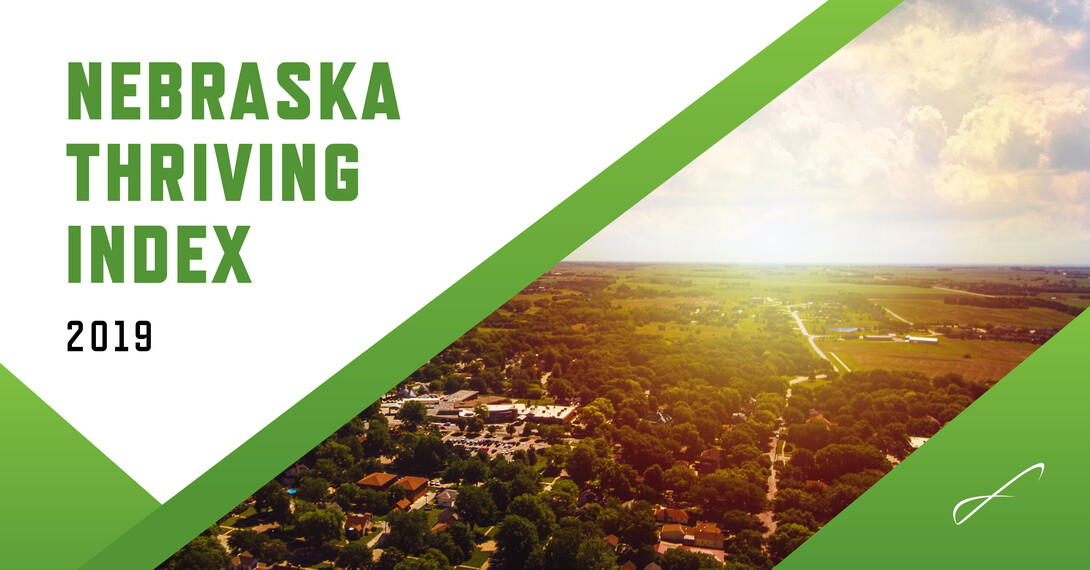
September 18, 2019
Lincoln, Neb. — According to the first annual Nebraska Thriving Index rural regions in the state are relatively strong for economic growth, quality of life and social capital. Concerns from the findings are in education and skill, which includes education attainment, labor force participation and employment in knowledge-based occupations.
Developed by researchers and students within the Bureau of Business Research at the University of Nebraska–Lincoln College of Business and the University of Nebraska at Kearney College of Business and Technology, the Nebraska Thriving Index is a benchmarking tool to help leaders spot trends and drill down into potential causes at a regional level.
Nebraska Thriving Index the is the first report of its kind for rural areas of the state with indexes developed specifically for the rural context. It is supported and administered by the Rural Futures Institute at the University of Nebraska, and both the full report and interactive comparison tool are available at ruralfutures.nebraska.edu/nethrivingindex.
Eric Thompson, Director of the Bureau of Business Research, leads the Nebraska Thriving Index research team. He also leads the data collection and analysis for the Omaha Barometer and Lincoln Economic Dashboard, which alerted him to the critical need for rural communities, and the state as a whole, to have the same type of analysis.
“What our rural community leaders were working with in terms of data collection and analysis as well as comparison localities were not at as actionable as they could be,” Thompson said. “They needed true peers to gauge their successes and shortcomings, and they needed data collected with the rural context in mind. Now they have it.”
In total, eight rural Nebraska regions were created in an iterative process, which considered Nebraska Economic Development Regions, Nebraska Economic Development Districts, information from the Nebraska Department of Labor and the expertise of project participants.
Peer regions were selected via the Mahalanobis matching technique, which compares all regions according to the fundamental economic characteristics of each region, such as total population, economic structure and urban orientation. A list of five to eight benchmarking regions was selected based on the similarity according to these characteristics.
Three indexes calculate economic growth and five indexes quantify economic conditions in rural Nebraska. Within each index, there are four to 10 variables, resulting in nearly 50 measures of data. The data was collected by four undergraduate research assistants from entities such as the Bureau of Labor Statistics, American Community Survey, state websites and more.
“To have this quality of data and analysis so accessible and immediately usable frees up our limited resources to focus on strategies and implementation,” said Sharon Hueftle, executive director for Nebraska’s South Central Economic Development District. “We can target specific measures that we believe will help us reach our goals, and the year-over-year report will show us whether or not we’re making progress. This is a really significant contribution from the University to rural Nebraska, and we plan to help the research team continue to refine it.”
In terms of economic development, findings suggest that growth has been relatively strong in Nebraska’s micropolitan and small metropolitan regions, with three of eight regions ranked first among their peers.
Micropolitan and small metropolitan regions also performed well in quality of life, which includes commute times, relative wages, public safety, climate and recreational amenities, and access to health care, day care, parks, and arts and cultural opportunities. Quality of life is critical for attracting and retaining residents in a region. Three regions all ranked first among their peers.
Nearly all Nebraska regions rank high relative to their peers for social capital. The Sandhills region ranks first among its peers while the North 81, Northeast, Siouxland, and Southwest regions all rank second and the Southeast and Tri-Cities regions rank third. The Panhandle region ranks fourth.
“The Rural Futures Institute envisioned this tool as a tangible deliverable to empower rural communities forward,” said Katelyn Ideus, RFI director of communications and public relations. “Getting it into the hands of economic developers, school and hospital administrators, elected officials and other stakeholders is really exciting for us. We believe the Nebraska Thriving Index can help them clarify their pursuits, substantiate their causes and demonstrate their successes. And we encourage everyone to reach out to us to help us evolve it as we look to publish again in 2020 and 2021.”
Nebraska regions listed with thriving index score (100 = peer average) and ranking among peers
North 81
144
1st
Northeast
103
3rd
Panhandle
98
3rd
Sandhills
109
2nd
Siouxland
105
3rd
Southeast
112
3rd
Southwest
95
5th
Tri-Cities
136
1st
Katelyn Ideus
Director of Communications and Public Relations
Rural Futures Institute
402-659-5886
kidus@nebraska.edu







